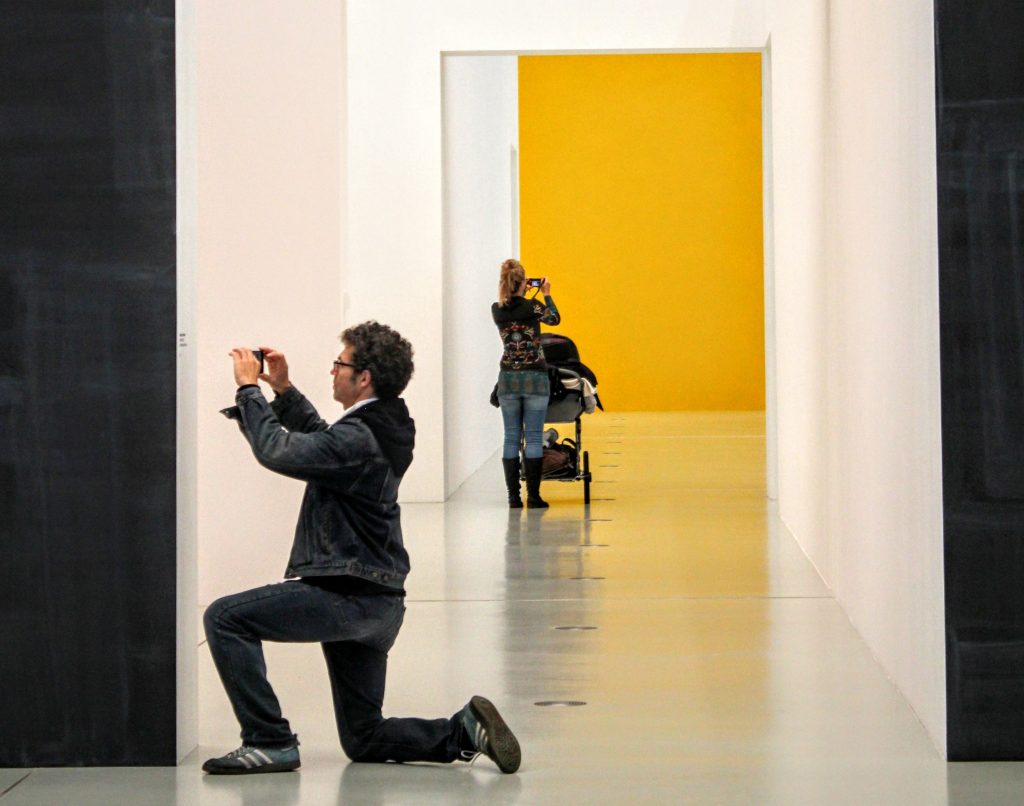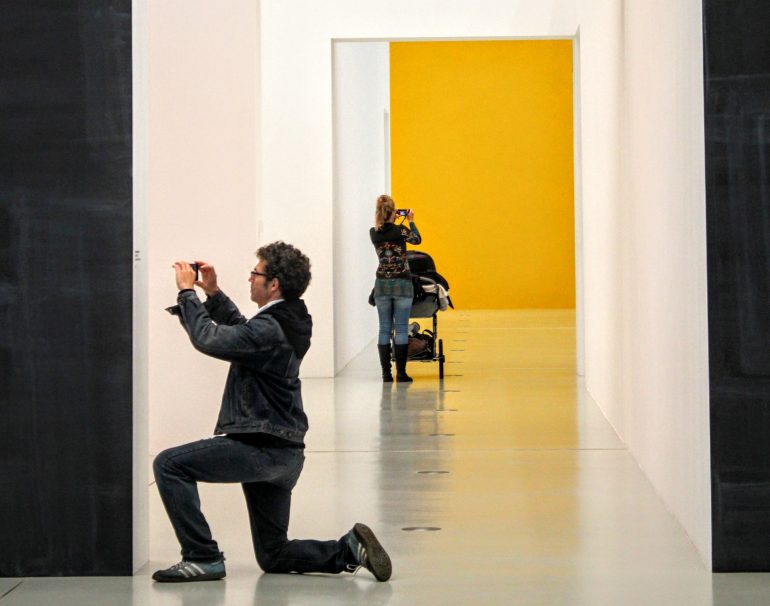Becky Tuch

Hello! And Welcome! We are so glad to see you here at the Museum of Historical Alternative Invisible Everythings! First, please take a moment to make sure your audio buds are properly adjusted. Has the earwax been cleaned off? The device completely charged? Fabulous! We are now ready to begin our journey through the marginal unseen everywhere underneath.
Let’s begin in the first room, The Robert Q. Thornbick Wing of Wonders. Some of you may have heard of Robert Q. Thornbick. Philanthropist and entrepreneur, Thornbick is also well known for his advocacy of the 1892 Freedom to Work Act. Thanks to this act, many children under the age of ten were given the freedom to work. They worked in factories all over the city! Many such children helped dig the coal that would build the cement for this very museum! Amazing!
Now let’s turn our attention to the first image on our left. Here we have one of the early examples of the Spanish Franciscan papal portraiture style. While for the painting we have Albierto Giatomiti di Sevilla to thank, for the wooden frame we can thank Benny Wilkins of Detroit, Michigan.
It was Benny, after all, who got the assignment to pick up the wood from the facility out in Shasta and do the cross-country truck route in order to drop the wood off at the frame store, here on the east coast. And it was Benny who sat through hours of gridlock traffic on the I-94, bladder near-bursting after the rookie mistake of chugging sixteen ounces of RC Cola at the last rest stop, half distracted by worry about the coming storm. A storm which, if it slowed him down, might set him back a few hours, and those are hours Benny might not get paid for, ever since their one trucking company got bought up by some other company that now has a boss Benny’s never even met, plus a whole crew of dispatchers who aren’t even people but some kind of AI robots who sure as hell do not understand when Benny and his crew try to explain about bingo cards, Big R’s, bull dogs or being bundled out. Hell, man, is it any wonder half his best friends quit last year? Well, Benny has more than half a mind to quit too. He’s tired of driving, sick of traffic and motel beds, and is disgusted by the coat of diesel-fuel grease that covers his own face every night. But if he’s not driving, where would Benny go?
But back to the frame. After Benny did the drop, called in the report, signed the paperwork and headed home to sleep for two straight days, the men at the framing store took over. There, the men used hot glue to ease the corners of the frame slats together, careful not to drip the glue on fingertips, scalding the skin, as so many had done in the past.
Unfortunately for them, the museum was late in giving the order, because museums are always late giving in their orders, and it had to be a rush job, because museums always want rush jobs, so Joseph Stein, the store owner, had to call his wife, Abigail Stein, to come in and help, which meant that she, Abigail, had to leave their three-year-old with the next-door neighbor at the last minute.
When, after hours of fastidious and hyper-focused work, Abigail got home, just after midnight, she was distraught to see her child still awake, watching Pay-Per-View and stuffing his face with chocolate cupcakes. Little Sammy Stein stared at her with big glazed TV-soaked eyes and Abigail sighed, knowing her son would now be up all night and a monster in the morning when he had to go to school, and while Joseph was sleeping, it would be Abigail, who else, who wrestled him into clothing and answered his incessant questions and wiped up the cereal he splattered across the floor so that now, even as she thanked the next-door neighbor profusely, she felt like weeping because why on Earth did everything have to be so hard all the time and when did she, Abigail, ever get a break, and goddammit this entire week was just frankly going to be fucked.
Shall we move on?
In the center of the room, of course, is our most popular attraction. First, let’s take a moment to observe the artwork’s plaque. This is an alloy steel plaque, manufactured in Mexico City by a man named Marco Cardena. Marco is just nineteen, but he’s a pro at withstanding heat from the blast iron furnace and was quick to grasp the Bessemer Process, in which he removes impurities from molten iron by blowing air through it, giving it the nice smooth texture you see before you now.
Marco is supposed to wear a mask when he does this work, but the mask fits too tight and clips his ears, so he usually skips it, and honestly? No one cares. Sure the factory foremen like to talk about safety. But who takes them seriously when just last month one of the electrical resistance pipes caught fire and they wouldn’t let anyone leave? No, man. You can save your pretty words about taking all necessary precautions. Marco has a job to do.
And even though he has no idea what happens to this steel once it leaves this building, and even though if he did know he might be shocked to learn that this museum’s admission fee is the equivalent of two and a half days of work for him, Marco does his job, never thinking twice about what this steel plaque will one day become, whose art it will adorn, and what ungodly sum that art will be selling for once it goes up for auction, a number so high that to most people it sounds imaginary.
But wait. Before we turn to the art, let’s look again at the plaque, this time turning our attention to another layer of it: the words upon it. These were written by Jill Marsh. Oh, poor Jill Marsh. She’s got a chip on her shoulder and no one knows why. Only, Jill knows. She knows, at least thinks she knows, that going to graduate school was a mistake. How could she have been so stupid? Follow your passions! Her family said. But also: Get some loans. Well, Jill did both and now she’s got no time for friends, no time for dating, not even time for small talk, because all Jill can think about these days, when she’s not writing descriptions of art, is the interest accruing on her loans, and how somehow this number seems to keep getting higher? How is it possible she owes more now than she did two years ago? How is any of this possible? And if she’s tired, which lord knows she is, and grumpy, which yes, also true, it’s because she just applied to be an uber driver, which is the absolute last fucking thing Jill wants to spend her nights and weekends doing, but she has no choice, does she, because this job of writing descriptions of art, while pleasant, and engaging, and exactly the sort of thing she always saw herself doing, pays absolute shit, and the benefits are shit, and the retirement package is shit, and she is almost thirty-four years old, shouldn’t she be married and pregnant or something by now? Instead of hustling like a maniac from one job to the other and worrying constantly about money so that she hardly can even think straight when it’s time to write words describing this work of art here? So as we look at this plaque, and read its inscription, pretend we do not see that comma splice. Let’s all give Jill Marsh some space.
The sculpture itself is, as everyone knows, made entirely of lard. But how, we must ask ourselves, was this lard sculpture transported to this spot? It’s a good question! Dean Darling is an intern, and so is Tamika Miles. Together, they ever so gingerly maneuvered the lard sculpture with gloved hands, without speaking a word, sweat beading on their upper lips, walking back to front up the museum steps. Setting it down more gently than a baby lamb, they then wiped their foreheads, looked at each other and locked eyes over the lard sculpture’s large conical tip.
Later, after ensuring the lard sculpture’s steadiness, after alphabetizing an entire back catalog of 1950s retrospectives, scanning hundreds of pages of printed matter for the museum’s digital archives, answering phones and redirecting calls to the appropriate offices, making photocopies, picking up lunch and coffee, and after spending many minutes trying to look at once more busy and less awkwardly in the way, Dean and Tamika went out to a bar downtown, a cheap one, since neither of them were getting paid at the museum, and got buzzed, then drunk, on two-dollar drafts of PBR, and then, together, stumbled drunk into the bathroom for a messy and not-quite-sexual encounter, both of them blindly exploring each other’s bodies while also, if you really want to know?, actually not all that attracted to each other, just sort of thinking, god, it’s so strange to work so hard and not get paid and maybe this, here, now, was something, a tangible reward they could take all for themselves.
Only in this case the reward wasn’t exactly a reward, though it was tender enough, and gentle enough, but also kind of, just, tiring, in the end, and they both left soon after, sharing a Lyft to their respective unaffordable shoebox apartments, hands clasped over the car’s suspiciously clean backseat, both of them refusing the mint candies cheerfully offered by their driver who, unbeknownst to them, had a day job teaching Art History at three different colleges.
Finally, it is worth taking note of the gallery’s overall space. The “White Cube,” as it is called in the industry. Perhaps there are simply too many details to consider–the architect, Trent Rankin, who almost backed out at the last minute over a financial quibble with the museum director; the white wall here painted by Leroy King, who pulled a muscle in his back as he folded up his ladder. “Goddammit pisschrist cocksucker!” he shouted, which made a few of his fellow painters laugh, but more in a frightened way, because of course it could just as likely have happened to them.
Let’s, though, turn our gaze to the floor. Clean, white, smooth. For this we can thank Jenya Jones, who sweeps nightly. Jenya works for the cleaning company Ferocious Dazzle!, and all its members arrive each night at the museum, well after closing, carrying mops and buckets, brooms and dustpans, in order to clean bathrooms and empty trash cans, hidden from the naked eye of art viewers. But not hidden, of course, from the art. Nor does the art hide from them.
It is for this reason that as Jenya sweeps each night, she allows the whish and hush of the broom bristles to lull her into a drifty dreamy wondering state. She gathers dust into balls and scoops them into the trash. She scrubs at sneaker scuff marks and clots of dirt with a razor blade. But it is the sweeping, always, that sets her mind adrift.
What, Jenya wonders, might it be like to have her own art in a museum one day? What would such art even look like? And where, she asks herself, where in the world might such a museum be?
Becky Tuch is a writer and teacher based in Pittsburgh, PA. Her work has appeared in numerous magazines and anthologies including Salon, McSweeney’s, Tikkun, Virginia Quarterly Review online, Post Road, Salt Hill and Best of the Net. Find her at www.BeckyTuch.com and on Twitter at @BeckyLTuch.

